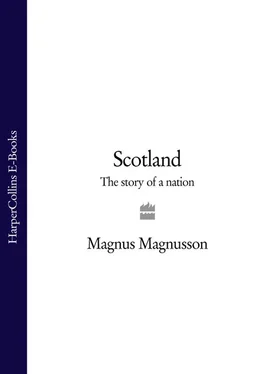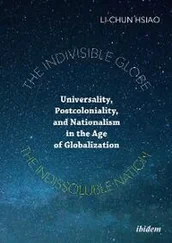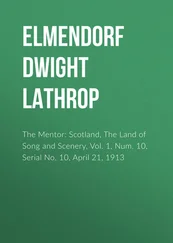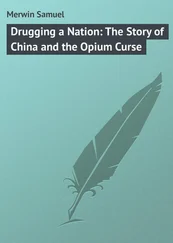With Lulach dead, Malcolm’s hold on the kingdom was at last secure. A month later he was crowned at Scone at the age of twenty-seven, and embarked on his thirty-five-year reign as King of Scots ( see Chapter 5).
So what were Shakespeare, and Sir Walter Scott following him, playing at? Why did they present such an extraordinarily biased view of Macbeth?
Shakespeare had not simply made it all up; nor had Holinshed in his Chronicle. The denigration of Macbeth had started much earlier, by John of Fordun in Chronica Gentis Scotorum (Chronicle of the Scottish People), his proto-version of the Scotichronicon around 1380: 1 here Macbeth is portrayed as an evil murderer and usurper. Andrew Wyntoun, prior of St Serf’s in Loch Leven and author of the metrical Origynale Cronikil of Scotland in vernacular Scots around 1420, introduced the witches and the advancing Birnam Wood and the theme of ‘unnatural birth’. It seems clear that conflicting stories about Macbeth and Malcolm were current soon after Macbeth’s reign: pro-Macbeth stories in the heartlands of Moray, and anti-Macbeth stories which were nurtured by the court propagandists of the victorious Canmore dynasty. These were the tales which Holinshed relied upon in his Chronicle.
Did Shakespeare believe what he read in Holinshed? For a playwright, it scarcely mattered – he must have found Holinshed extraordinarily convenient. He wrote Macbeth in the period around 1606, soon after the Union of the Crowns of 1603 which had brought King James VI of Scotland to London as King James I of England as well. James was the latest of the Stewart dynasty of Scotland, and Banquo (who seems to have been an invented character) was, providentially, the legendary progenitor of the Stewart monarchy. What more flattering than such a theme for a play presented by The King’s Men to welcome the new incumbent of the throne? Shakespeare was in no way averse to twisting history for political ends: ten years earlier he had played fast and loose with the story of Richard III to celebrate the first of the Tudors, Henry VII, in order to please his demanding royal patron, Queen Elizabeth.
It was also well known that King James VI and I was deeply interested in witchcraft – his book on Daemonologie , first published in Edinburgh in 1597, had been republished in London on his accession in 1603. Furthermore, the mere fact that Macbeth had caused the death of a reigning king made him automatically, in Elizabethan eyes, a regicide and a usurper, even though kingship in Macbeth’s day was decided by election, not inheritance – as the succession had been in England at the death of Edward the Confessor in 1066.
There was less immediate excuse for Walter Scott, however. Ted Cowan says:
The Macbeth episode in Tales of a Grandfather has always puzzled me because Scott simply regurgitated the plot of Shakespeare’s play. His account gives the impression of Macbeth the usurper, Macbeth the barbarian king, Macbeth the tyrant who would massacre his own subjects, and so on; yet Scott knew that this was far from the historical truth – if there is such a thing as historical truth!
Scott was perhaps trying to set up a contrast between the disappearing old Celtic world and the wonderful new world of the Normans as portrayed in Ivanhoe and other novels; he was personifying the dissolution of Celtic Scotland in the figure of Macbeth. That may be all right in literary or artistic terms, but it is certainly not legitimate in strictly historical terms.
So Tales of a Grandfather presents the demise of Macbeth as a happy prelude to the normanisation and ultimate anglicisation of Scotland to come. For pro-Unionist historians like Scott, the denigration of Macbeth reflected a profound distaste for the ancient role of Celtic culture in the Lowland Scotland of his day; for Scott, any relevance it might have had was overshadowed by the emerging Norman (i.e. civilising) influence which was to begin in the reign of Malcolm Canmore. Not that Scott himself would have admitted to any such notion; in his History of Scotland he showed clearly that he was aware of the historical inaccuracies of Shakespeare’s plot:
All these things are now known: but the mind retains pertinaciously the impression made by the impositions of genius. While the works of Shakespeare are read, and the English language subsists, History may say what she will, but the general reader will only recollect Macbeth as a sacrilegious usurper, and Richard [III] as a deformed murtherer.
It is only in much more recent times that Macbeth has been rehabilitated as the champion of the Men of Moray and the last truly Celtic king of Scotland.
But there was another player in the Macbeth drama whom Shakespeare did not mention at all – Thorfinn the Mighty, Earl of Orkney. The sources about Thorfinn’s life (both Icelandic and Scottish) are tantalisingly elusive about his real impact on Scottish affairs – so elusive, indeed, that the eminent Scottish historical novelist Dorothy Dunnett was able to create a brilliantly plausible scenario from them in her novel King Hereafter (1982). Her thesis was that Macbeth and Thorfinn were in reality the same person, known as Thorfinn in Orkney and Macbeth in Scotland. It may sound outrageously unlikely, but …
Orkneyinga Saga relates that on the Feast of the Assumption (10 August) in 1040 – the very day on which Macbeth defeated Duncan near the village of Pitgaveny in Aberdeenshire – Thorfinn defeated a King of Scots called ‘Karl Hundason’ in battle at a fortified site the saga called Torfnes, somewhere on the northern coast of Scotland. It is impossible to identify the site with any certainty, but circumstantial evidence suggests that ‘Torfnes’ may well have been a name for the large and important fortification at modern Burghead, on the north Moray coast, near Elgin. Meanwhile John of Fordun’s early version of the Scotichronicon relates an old Scottish tradition that after Duncan’s death at Pitgaveny in 1040, his body was taken to Elgin; it was this tradition which, two centuries later, in 1235, inspired King Alexander II to found a chapel in the cathedral church in Elgin where masses were sung for Duncan’s soul.
In the year 1050, when Macbeth went on his pilgrimage to Rome, Orkneyinga Saga tells us that Thorfinn the Mighty went to Rome as well. Was it pure coincidence that these two rulers should choose the same year in which to absent themselves from their respective warring domains for such a long time? Thereafter, according to the saga, Thorfinn maintained good relations with the Scottish court.
There are just as many inconsistencies as coincidences between the stories of Thorfinn and Macbeth, of course. According to Orkneyinga Saga , for instance, Thorfinn died peacefully in Orkney and was buried in his beloved minster of Christchurch on the Brough of Birsay; whereas Macbeth, as we have heard, was buried on Iona. But both the saga and the Scottish sources agree that Thorfinn was married to Ingibjörg, the daughter of Earl Finn Arnason of Norway, and that after Thorfinn’s death she married Malcolm III – Macbeth’s conqueror and successor as King of Scots. Intriguing, isn’t it?
1Local tradition in Inverness insists that the murdered King Duncan was buried in Culcabock, a village to the east of the town (now a suburb of it). In front of a petrol station on the Old Perth Road, at the junction with Culcabock Avenue, is a stone marked with a plaque which reads: ‘Behind is the supposed burial place of King Duncan 1040’ – that is to say, underneath the present petrol station. On the opposite side of the road is a ‘Duncan’s Well’ ( Fuaran Dhonnachaidh ). According to this tradition, the king’s body was later removed and buried in the royal cemetery on the Holy Island of Iona. In fact, Duncan was killed in battle in Aberdeenshire ( see here).
Читать дальше












